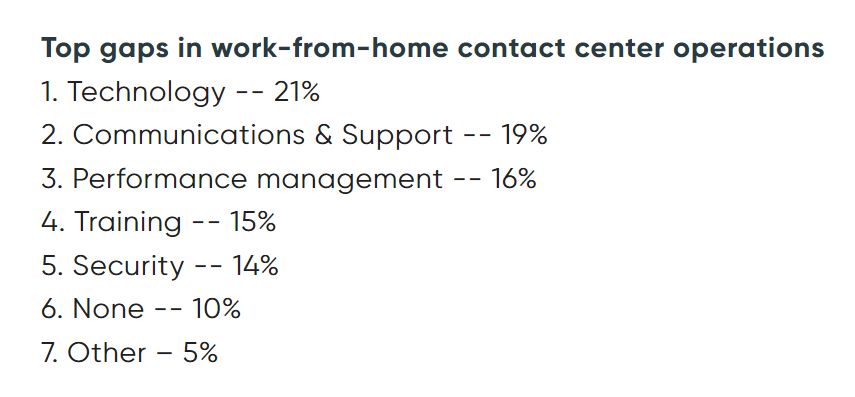Remote work has become the new norm for many of us. Our latest MEOS report, anticipates that the demand for talent in the communication services industry will continue to increase as contact centres continue to adopt a remote working model. With an increase in staffing levels, needs have changed for the CC&CS industry, where 24/7 service availability is expected and work patterns constantly changing. Providing flexible and remote work in contact centres has become an essential solution, to maintain activity and quality of service delivered to customers.
How do we organise remote work while maintaining the performance of our agents? What changes must be made to practice, technology and organisational structure? What steps should we take to ensure that working from home does not adversely affect the efficiency, quality and performance of our contact centres?
What is a virtual contact centre?
A virtual contact centre has the same functionalities as an on-premises call centre. However, in a virtual contact centre, therefore in SaaS mode, employees do not necessarily take calls from their office or the Customer Relations centre platform. People connect from home, with a device and internet connection to carry out their mission of advising - with the same efficiencies working remotely as from an office. Similarly, supervisors can, in this fragmented call centre context, manage the activity of the service with as much finesse as if all teams were on site.
A virtual contact centre is therefore very advantageous from different points of view:
Diversity & Inclusion

The talent pool is widened when advisers can work from home. Thus, people with disabilities, reduced mobility or family and relatives to care for, who are equally qualified and motivated, can then apply and be recruited. This opens up new audiences to recruit from for CC&CS organisations who must continually find talent to offset the sector’s elevated churn rate.
Reduced costs
Premises costs can be significantly optimised by moving agents to a remote contact centre. Thanks to remote customer service teams, companies can do without a physical contact centre, or reduce its size. This results in considerable savings for both employees and employers such as real estate, office supplies, transportation costs, equipment, etc.
However, for effective contact centre management, companies will still need to use a purpose-built solution for the cloud and provision resources to remote agents.
Happy workforce = Better productivity
Absenteeism is significantly reduced when employees work from home, even if only partially. Fewer illnesses, less fatigue, fewer obstacles (transport strikes, bad weather, etc.), employees are then more present than before… at home!
These benefits create a positive atmosphere that carries over to customers, allowing for better interactions and less stress, resulting in a better experience for agents, supervisors, managers, and customers.
The uniqueness of the remote work environment

https://www.ttec.com/articles/how-well-did-contact-centers-shift-remote-work
Over time, long-term consequences began to appear in this new working reality:
Technology
While the need for hardware is reduced thanks to the cloud, organisations must be prepared to provide agents with the right technology such as laptops, headsets equipped with microphones and a high-quality internet connection to ensure that they work in the best conditions. Supervisors and call centres managers must stay connected with remote agents and maintain their engagement while appropriately monitoring customer and staff productivity and happiness using features such as omnichannel routing, activity monitoring and analytics, and response assistant.
Policies
Prioritise the needs of your business and determine which traditional structure and policies best meet those objectives. Strong work-from-home policies are beneficial as they will assist you in streamlining operations and the demands placed on your remote workers. Additionally, it offers precise directions and instructions on how to work from home most productively so they may continue to meet their goals as well as the goals of your entire company.
Performance Management & Task-based Productivity
The way agents’ performance is managed is crucial for organisations or managers. Leaders frequently use time-based productivity because they feel more at ease when they can "see" their subordinates at work. If the leader in a remote working structure has this attitude, it is a sign of a lack of trust in the workforce and the organisation will not succeed.
In order to tackle that issue, leaders should:
Acknowledge task-based productivity which enables employees to work where, how, and when they want – thus, attracting the best talent, regardless of life circumstances that make it hard for some people to work an in-person 9-5 job
Avoid micromanaging and focus instead on the team result
Allow- agents to set their own schedule
Foster a culture of open communication and clear expectations
Most importantly, organisations must continuously provide upskilling and reskilling training to bridge the skills gap and empower employees to help them provide excellent customer service.
Proactivity & Transparency
In a work environment where everyone isn’t always online or at the same time, it would seem impossible to expect everyone to attend important meetings outside of their specific work hours. Be transparent about the reasons for shifting to a virtual/remote work when you begin the transition:
Create a daily meetings period from 10 am to 2 pm during which all agents should be available to join meetings as needed
Employees may learn to better assess the urgency of their requests: do they really need a meeting immediately to resolve their issue? Would it be possible to resolve the issue through an email, answered within the next working day?
A successful week will depend on proactive scheduling and transparency, no matter how you approach it.
Because these strategies require deep resources to operate successfully, many CC&CS businesses may be unable to deploy them without external support.
Deploying a virtual contact centre has many benefits in terms of productivity, costs, and impact on the environment. A virtual call centre with remote split teams, which was only a simple idea a few years ago, has become a reality.
For contact centres that want to attract and retain top talent, it is necessary for them to review their current policies to ensure the needs of employees are being met. That’s where we can help and advise you.
At Brook Street, we work with contact centre candidates and employers every day and know what these needs are, and how they can best be met by organisations while keeping a keen eye on productivity and employee engagement. Hiring top talent for effective teams is our speciality.

